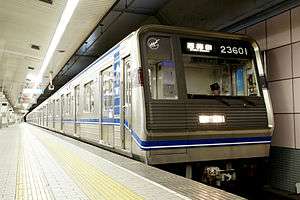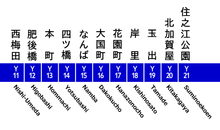Yotsubashi Line
| Osaka Metro Yotsubashi Line | |||
|---|---|---|---|
|
| |||
 A refurbished Yotsubashi Line 23 series EMU in August 2012 | |||
| Overview | |||
| Type | Rapid transit | ||
| System | Osaka Metro | ||
| Locale | Osaka, Japan | ||
| Termini |
Nishi-Umeda Suminoekōen | ||
| Stations | 11 | ||
| Line number | 3 | ||
| Operation | |||
| Opened | May 10, 1942 | ||
| Owner |
Osaka Metro (2018–present) Osaka Municipal Transportation Bureau (1942–2018) | ||
| Depot(s) | Midorigi, Morinomiya (located on Chuo Line) | ||
| Rolling stock | 23 series EMUs | ||
| Technical | |||
| Line length | 11.4 km (7.1 mi) | ||
| Track gauge | 1,435 mm (4 ft 8 1⁄2 in) | ||
| Electrification | 750 V DC, third rail | ||
| Operating speed | 70 km/h (45 mph) | ||
| |||
The Osaka Metro Yotsubashi Line (四つ橋線 Yotsubashi-sen) is an underground rapid transit line in Osaka, Japan, operated by Osaka Metro. The line connects Umeda, Hommachi, Yotsubashi, Namba, Daikokuchō and Suminoe, and runs parallel to the Midōsuji Line from Daikokuchō to Nishi-Umeda. Its official name is Rapid Electric Tramway Line No. 3 (高速電気軌道第3号線), while the Osaka Municipal Transportation Bureau refers to it as Osaka City Rapid Railway Line No. 3 (大阪市高速鉄道第3号線), and in MLIT publications, it is written as Line No. 3 (Yotsubashi Line) (3号線(四つ橋線)). Station numbers are indicated by the letter Y.[1]
Overview
the Yotsubashi Line runs in a north and south direction. connecting the Osaka Metro Nankō Port Town Line at Suminoekōen Station. At first, it was a branch of the Osaka Metro Midōsuji Line, branching off at Daikokuchō Station but was extended north to Nishi-Umeda Station and made a separate line. This new section of the Yotsubashi Line takes a more direct routing to Nishi-Umeda running only 300-400m east of the Midosuji Line.
Operations
Most trains are driving between Nishi-Umeda station-Suminoe-Koen Station, 2-3 minutes interval during the morning rush hour, 6-7.5 minutes interval during the day, 3-4 minutes intervals at night, 5-10 minutes nightly, early morning and midnight is about 10 minutes interval. During the rush hour in the morning and evening (Saturdays and holidays only), the train between Kita-Kagaya station and Nishi Umeda Station, which leads to the North Kagaya station, which is connected to the green tree Ching of the vehicle base, is also driven.
In addition, on the day of the Suminoe racing Night event, one special train will be issuance at 9pm.
The connection with the new tram is considered basically at Suminoe Park station. On March 23, 2013, the Osaka Municipal Subway line with the Sakai Muscle Line was revised to perform the timetable revision, the four-bridge lines to take advantage of the train that had been driving forward to the garage after the last train, the last train of up trains is 20 minutes, The last train for the downlink was 10 minutes (to Suminoe Park) and 26 minutes (North Kagaya), respectively.
Also, according to the actual use, the interval of 5 minutes between 10 a.m.-12 o'clock on weekdays, to every 6 minutes, the 5-6 minutes interval of 10 o'clock-15 o'clock on Saturdays and holidays, respectively, was changed to 7-7.5 minutes interval. Since 2016, the regular inspection of the vehicle of the third rail line of Osaka Metro has been carried out in the Green wood Ching field, the vehicle of Midosuji Line, Tanimachi Line, Chuo Line, and Sennichimae line may travel four bridge lines in the forward.
Stations
| No. | Distance (km) |
Station | Japanese | Connections | Location |
|---|---|---|---|---|---|
| Y11 | 0.0 | Nishi-Umeda | 西梅田 |
|
Kita-ku, Osaka |
| Y12 | 0.9 | Higobashi | 肥後橋 | Keihan Nakanoshima Line - Watanabebashi | Nishi-ku, Osaka |
| Y13 | 1.9 | Hommachi | 本町 |
| |
| Y14 | 2.9 | Yotsubashi | 四ツ橋 |
| |
| Y15 | 3.7 | Namba | 難波 |
|
Naniwa-ku, Osaka |
| Y16 | 4.9 | Daikokuchō | 大国町 | ||
| Y17 | 6.2 | Hanazonochō | 花園町 | Nishinari-ku, Osaka | |
| Y18 | 7.3 | Kishinosato | 岸里 | ||
| Y19 | 8.6 | Tamade | 玉出 | ||
| Y20 | 9.7 | Kitakagaya | 北加賀屋 | Suminoe-ku, Osaka | |
| Y21 | 11.4 | Suminoekōen | 住之江公園 |
Rolling stock
Current
- 23 series (since 1990)
All trains are based at Midorigi Depot. Since 2014, Yotsubashi Line trains are also able to access Morinomiya Depot located on the Chuo Line, after a connecting track was built between these two lines near Hommachi Station. Currently all trains are 8 cars long but subway platforms are long enough to accommodate trains up to 10 cars long except Suminoekōen Station which only has platforms long enough for 8 car trains.
Former
- 400 series (1942–1969)
- 1000 series (1956–1971)
- 1100 series (1958–1979)
- 1200 series (1958–1980)
- 50 series (1960–1980)
- 30 series (1972–1996)
History
- May 10, 1942 - Daikokuchō - Hanazonochō (opening)
- Construction stopped during World War II.
- June 1, 1956 - Hanazonochō - Kishinosato (opening)
- May 31, 1958 - Kishinosato - Tamade (opening)
- October 1, 1965 - Daikokuchō - Nishi-Umeda (opening)
- November 9, 1972 - Tamade - Suminoekōen (opening)
Plans
A northward extension to Jūsō Station is under review.[2]
See also
References
| Wikimedia Commons has media related to Yotsubashi Line. |
- ↑ 四つ橋線. Osaka Kotsu (in Japanese). Osaka Municipal Transportation Bureau. Retrieved 5 August 2014.
- ↑ 北ヤード新線、大筋合意 大阪市地下鉄四つ橋線乗り入れ. Asahi Shimbun (in Japanese). 9 December 2006. Retrieved 5 August 2014.
